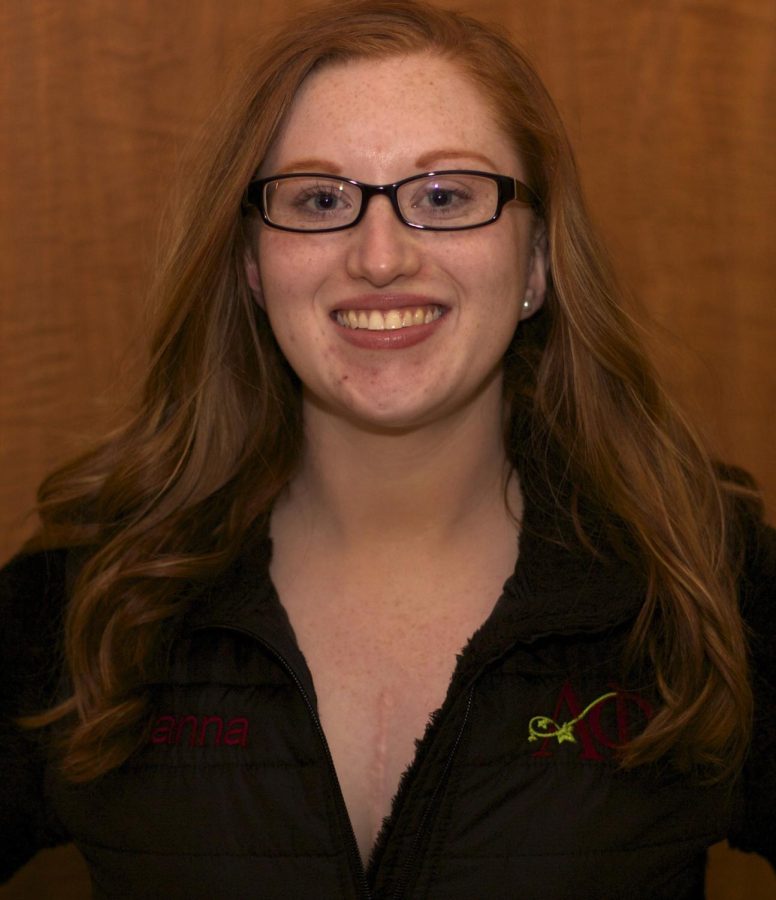Kent State student opens up about her life threatening condition
Hanna Dupee shows her heart surgery scar on Sunday Feb. 28, 2016. Dupee suffer frome life-threating heart conditions when she was younger.
February 28, 2016
Hanna Dupee swears she woke up laying on the surgical table. Powerless to move and unable to open her eyes or mouth, she listened to the muffled sound of tools clinking while doctors sewed up her chest.
“It was scary but at the same time I was not freaking out and actually felt calm,” Hanna said. “My mom thinks it was when they were taking me off the anesthesia, but why would I have this feeling of literally being sewn up? It’s really weird how vividly I remember that and how I couldn’t speak or anything but just lay there feeling that.”
While Hanna’s surgery cured her of a life threatening heart condition, her road to recovery and coming to peace with the large scar running down her chest would just be the beginning.
At 3 months old, Hanna was diagnosed with a congenital heart defect called ventricular septal defect. She was born with a hole in her left ventricle, which caused blood to flow between the left and right ventricles and into her lungs.
“She had a difficult time gaining weight and nursing from the beginning,” said Hanna’s mother, Laurie. “We would have to take her in to see her physician for weekly (weigh-ins) because she was not gaining appropriately. At her three-month checkup, the physician finally heard the murmur from the hole and sent us directly that day to Rainbow Babies Hospital in Cleveland to see a pediatric cardiologist.”
Hanna was prescribed the drug digoxin to regulate and slow down her heart. Before undergoing surgery at 9 years old, she was monitored every 3-6 months, had frequent electrocardiograms (EKGs), sweated profusely while eating or drinking and had chronic sleep issues.
As Hanna grew older, her parents and doctors hoped the hole would close on its own. But with another EKG showing blood leaking into her lungs, the decision was made for 9-year-old Hanna to undergo open-heart surgery.
“If they had waited any longer to do the surgery I would have just gotten even sicker and eventually developed lung problems,” Hanna said. “Because of how much blood was in my heart and lungs, it was slowing me down and my body was working overtime. I was much slower and just looked so sick all the time. I couldn’t really run without getting out of breath really quickly and sweating a lot.”
Hanna said she knew she was having surgery, but at such a young age she didn’t realize how serious it was and did not understand she would have a scar that changed her body forever. The then 9-year-old said it was scary to see her parents and family crying as she was wheeled away.
“It was the longest eight hours of our lives,” Laurie said. “When they wheeled her away from us it was the most helpless feeling a parent can have, giving your child to the hands of someone else. They had to stop her heart and place her on a heart and lung bypass machine while they completed the surgery. That alone is enough to scare any parent.”
After being described by doctors as a “failure-to-thrive baby,” Hanna’s family was relieved to hear her surgery went well. Hanna would now be able to keep up with kids her own age, sleep better, grow and keep weight on. Hanna, however, did not share their excitement.
“I was very upset after the surgery and I couldn’t understand why this was a good thing,” Hanna said. “I can remember taking the tape off my scar and after that moment I was just ruined. I had a very negative feeling about my heart condition for a long time. I hated my scar. Going back to school was hard because the other kids would just stare at it. So from fourth to tenth grade I never wore a shirt or dress that showed it, ever. I felt like it defined me. It was just awful.”
Her mother said it wasn’t until she began college at Kent State and joined her sorority, Alpha Phi, that she began to truly feel proud of her scar and what she endured. Today, Hanna embraces her scar and is happy to tell anyone how she got it.
Through her sorority’s philanthropy, Hanna has found a new way to connect to her heart condition. The Alpha Phi Foundation raises money and awareness for women’s heart health.
“She truly is my idol,” Laurie said. “Her strength during the process gave me strength in return. Having her sorority’s philanthropy be women’s heart health could not be more appropriate. Last year, when she spoke at the Red Dress Gala in front of so many people, I was so proud of her, I cried. She has become such a strong woman.”
Hanna believes everything happens for a reason. After going through recruitment and learning about Alpha Phi’s philanthropy, she finally understood why she had a heart condition.
Hanna said she realized she had to go through her heart condition and surgery because it led her to something so great. It led her to her best friends and, ultimately, changed her in a positive way.
Today, the senior fashion merchandising major lives free of her heart condition, but as American Heart Month comes to a close, Hanna said people shouldn’t stop thinking about this issue.
“For anyone who reads this, remember that yes, I had a heart problem, but I am very lucky that I don’t anymore,” Hanna said. “It’s important to know that there are a lot of people out there who still live with their heart condition, so always remember that those people have an important story to tell as well.”
Gabrielle Gentile is the recreation and fitness reporter for The Kent Stater. Contact her at [email protected].

























